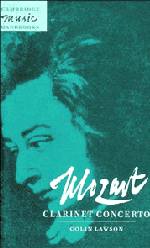Book contents
- Frontmatter
- Contents
- List of illustrations
- Preface
- 1 The eighteenth-century clarinet and its music
- 2 Mozart, Stadler and the clarinet
- 3 The genesis and reception of the Concerto
- 4 Stadler's clarinet and its revival
- 5 Mozart's original text
- 6 Design and structure
- 7 Performance practice
- Appendix 1 A review of the Breitkopf and Härtel edition in the Leipzig Allgemeine Musikalische Zeitung, 4 (March 1802)
- Appendix 2 Surviving instruments
- Appendix 3 A list of works composed by Mozart's clarinettist, Anton Stadler
- Notes
- Select bibliography
- Index
7 - Performance practice
Published online by Cambridge University Press: 05 June 2012
- Frontmatter
- Contents
- List of illustrations
- Preface
- 1 The eighteenth-century clarinet and its music
- 2 Mozart, Stadler and the clarinet
- 3 The genesis and reception of the Concerto
- 4 Stadler's clarinet and its revival
- 5 Mozart's original text
- 6 Design and structure
- 7 Performance practice
- Appendix 1 A review of the Breitkopf and Härtel edition in the Leipzig Allgemeine Musikalische Zeitung, 4 (March 1802)
- Appendix 2 Surviving instruments
- Appendix 3 A list of works composed by Mozart's clarinettist, Anton Stadler
- Notes
- Select bibliography
- Index
Summary
Introduction
Is the kind of performance expected by Mozart in his own day valid for later generations of players? We can never really answer this question, if only because so many relevant parameters have changed during the last couple of centuries. For example, the discipline imposed by the microphone and the implications of air travel are two factors which have brought about such changes that we cannot have the option to turn back the clock. Even if we could hear Anton Stadler's premiere of Mozart's Clarinet Concerto, we would not necessarily wish to adopt all of its features; like all performers of our own day (on modern or period instruments), we should continue to exercise elements of choice and taste as much characteristic of the twentieth century as of the eighteenth. But the mere fact that the original performance conditions can seem at all relevant now marks a radical shift in our musical thinking.
Period performance of Mozart and his contemporaries has recently been subject to reassessment in the light of the evidence of early recordings. As one eminent scholar in the field has succinctly put it, ‘If early recordings teach us anything, it is that no musicians can ever escape the taste and judgement of their own time’. Was there ever a time when our clean, accurate approach prevailed, as has recently been asserted in relation to Mozart's symphonies?
- Type
- Chapter
- Information
- Mozart: Clarinet Concerto , pp. 72 - 78Publisher: Cambridge University PressPrint publication year: 1996

